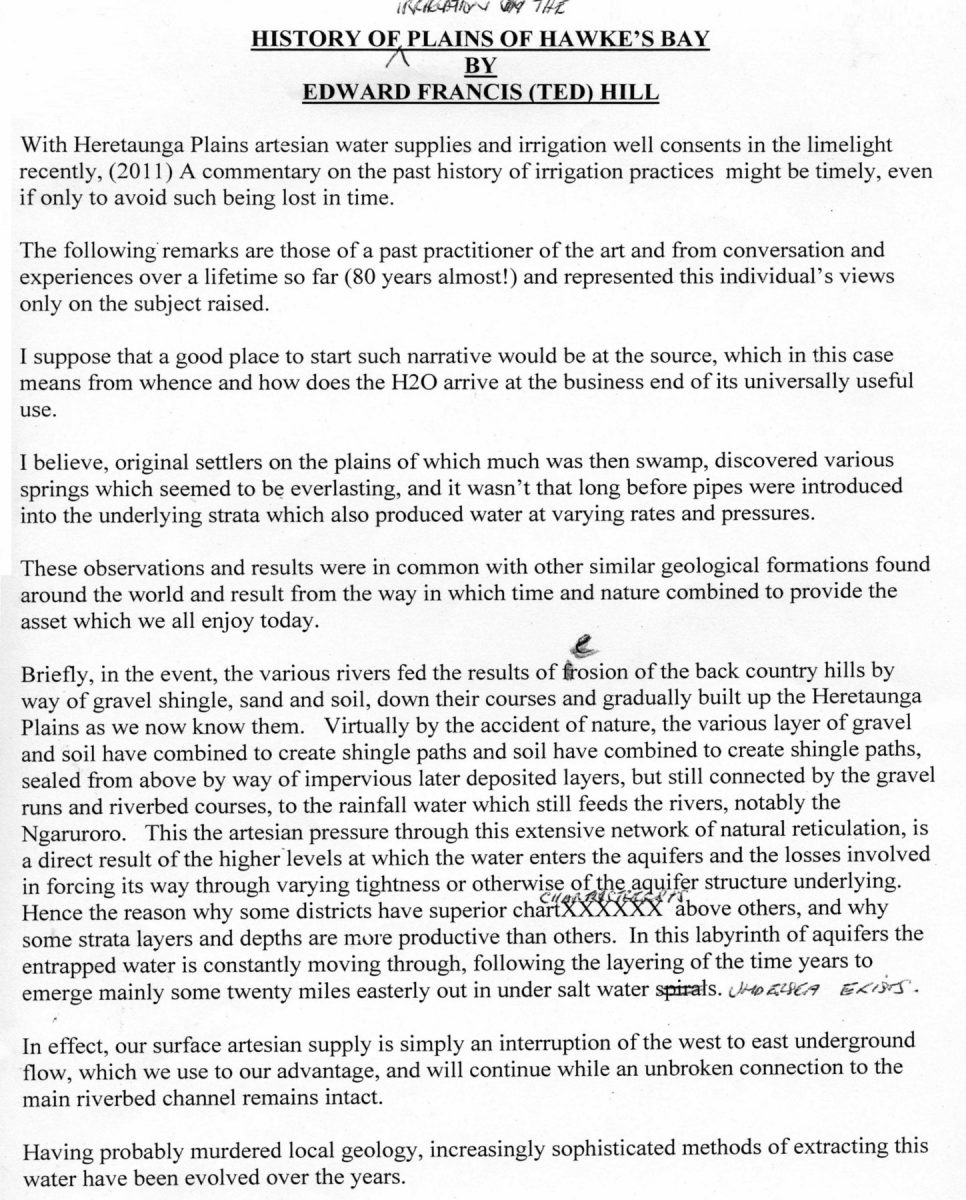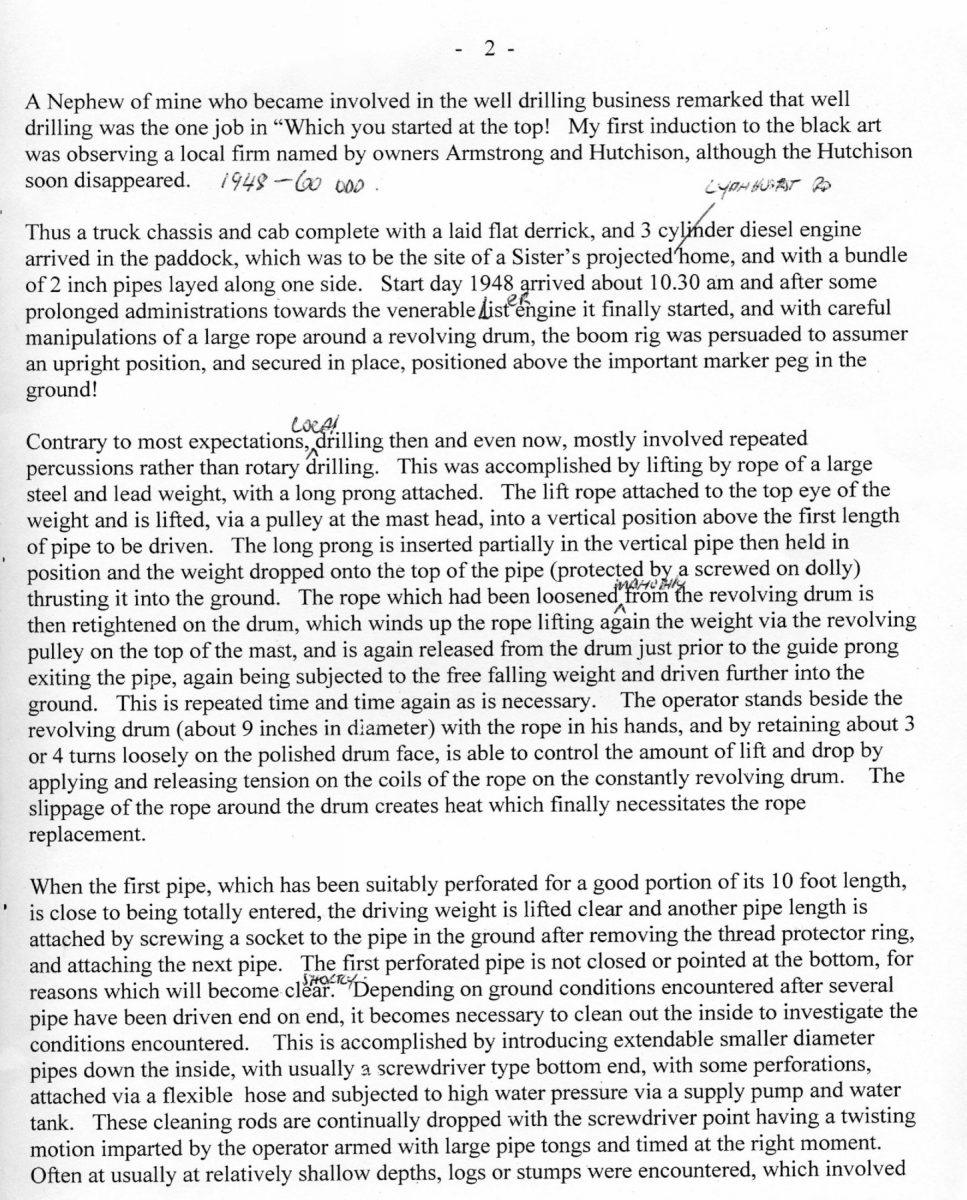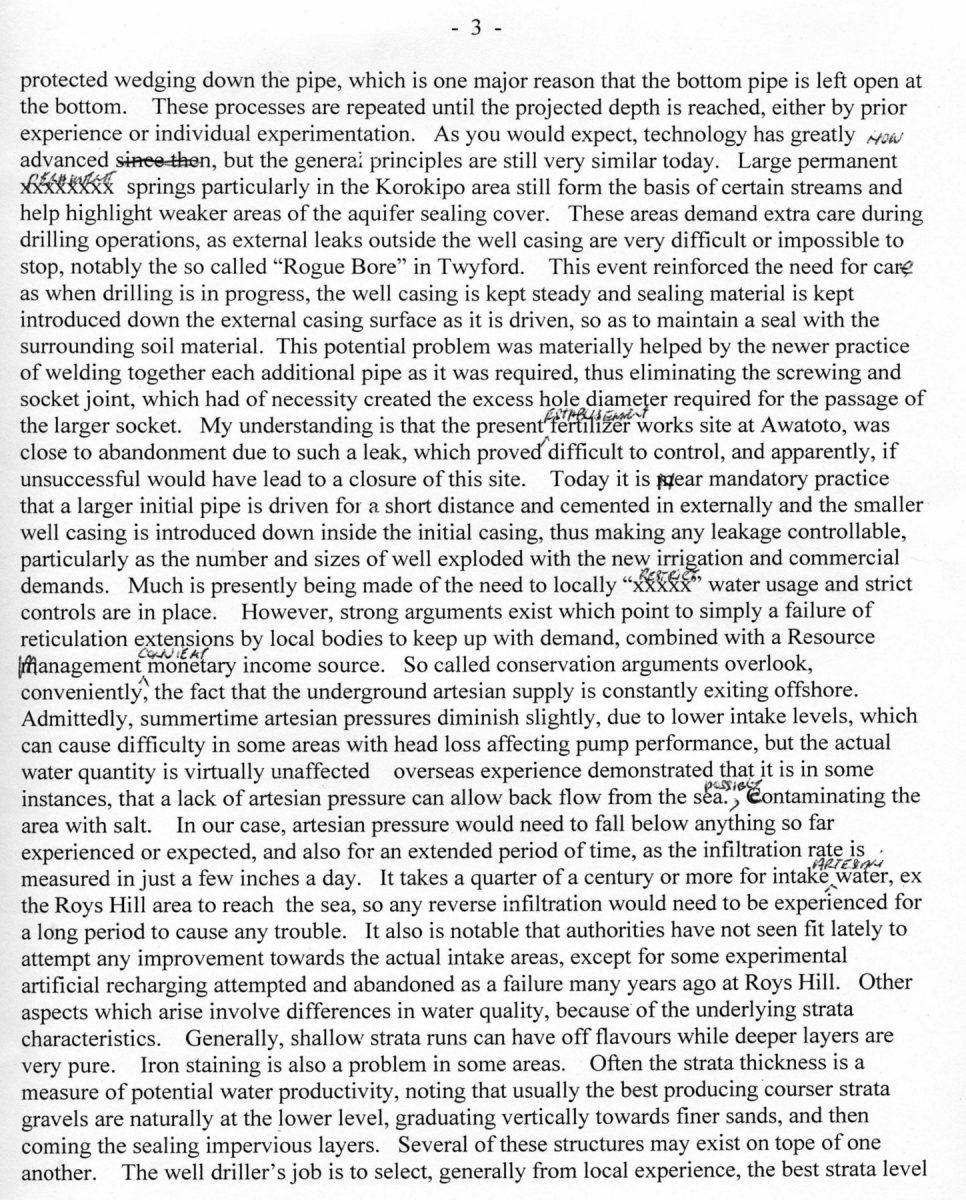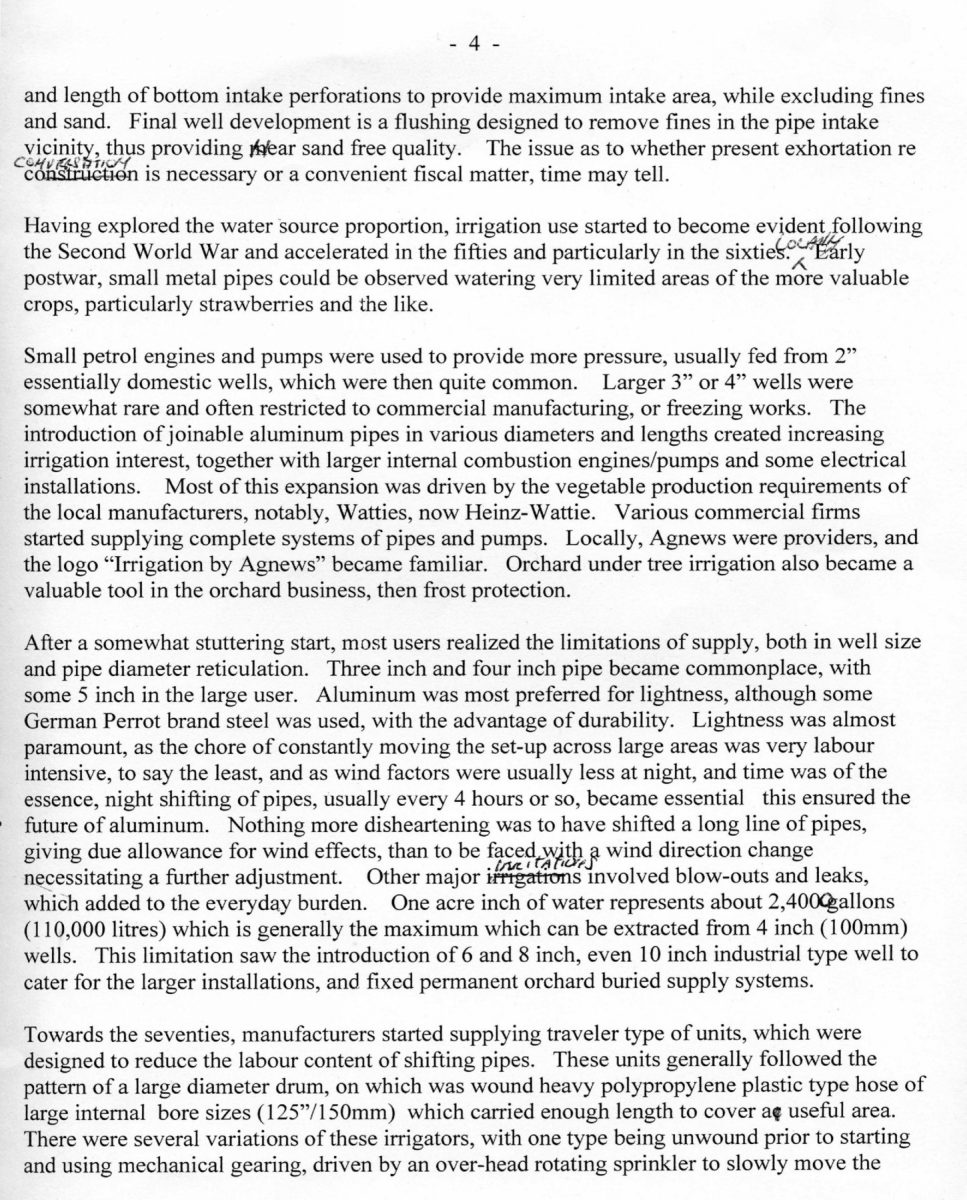- Home
- Collections
- HILL EF
- History of Irrigation on the Plains of Hawke's Bay
History of Irrigation on the Plains of Hawke’s Bay
HISTORY OF IRRIGATION ON THE PLAINS OF HAWKE’S BAY BY EDWARD FRANCIS (TED) HILL
With Heretaunga Plains artesian water supplies and irrigation well consents in the limelight recently, (2011) A commentary on the past history of irrigation practices might be timely, even if only to avoid such being lost in time.
The following remarks are those of a past practitioner of the art and from conversation and experiences over a lifetime so far
(80 years almost!) and represented this individual’s views only on the subject raised.
I suppose that a good place to start such narrative would be at the source, which in this case means from whence and how does the H2O arrive at the business end of its universally useful use.
I believe, original settlers on the plains of which much was then swamp, discovered various springs which seemed to be everlasting, and it wasn’t that long before pipes were introduced into the underlying strata which also produced water at varying rates and pressures.
These observations and results were in common with other similar geological formations found around the world and result from the way in which time and nature combined to provide the asset which we all enjoy today.
Briefly, in the event, the various rivers fed the results of erosion of the back country hills by way of gravel shingle, sand and soil, down their courses and gradually built up the Heretaunga Plains as we now know them. Virtually by the accident of nature, the various layer of gravel and soil have combined to create shingle paths, [and soil have combined to create shingle paths] sealed from above by way of impervious later deposited layers, but still connected by the gravel runs and riverbed courses, to the rainfall water which still feeds the rivers, notably the Ngaruroro. This [Thus] the artesian pressure through this extensive network of natural reticulation, is a direct result of the higher levels at which the water enters the aquifers and the losses involved in forcing its way through varying tightness or otherwise of the aquifer structure underlying. Hence the reason why some districts have superior chartXXXXXX [characteristics] above others, and why some strata layers and depths are more productive than others. In this ???]labyrinth of aquifers the entrapped water is constantly moving through, following the layering of the time years to emerge mainly some twenty miles easterly out in [under] salt water undersea exits.
In effect, our surface artesian supply is simply an interruption of the west to east underground flow, which we use to our advantage, and will continue while an unbroken connection to the main riverbed channel remains intact.
Having probably murdered local geology, increasingly sophisticated methods of extracting this water have been evolved over the years.

Page 2
A Nephew of mine who became involved in the well drilling business remarked that well drilling was the one job in “Which you started at the top! My first induction to the black art was observing a local firm named by owners Armstrong and Hutchison, although the Hutchison soon disappeared. 1948-60 000.
Thus a truck chassis and cab complete with a laid flat derrick, and 3 cylinder diesel engine arrived in the paddock, which was to be the site of a Sister’s projected Lydnhurst [ Lyndhurst ] Rd home, and with a bundle of 2 inch pipes layed along one side. Start day 1948 arrived about 10.30 am and after some prolonged administrations towards the venerable Lister engine it finally started, and with careful manipulations of a large rope around a revolving drum, the boom rig was persuaded to assume[r] an upright position, and secured in place, positioned above the important marker peg in the ground!
Contrary to most expectations, local drilling then and even now, mostly involved repeated percussions rather than rotary drilling. This was accomplished by lifting by rope or a large steel and lead weight, with a long prong attached. The lift rope attached to the top eye of the weight and is lifted, via a pulley at the mast head, into a vertical position above the first length of pipe to be driven. The long prong is inserted partially in the vertical pipe then held in position and the weight dropped onto the top of the pipe (protected by a screwed on dolly) thrusting it into the ground. The rope which had been loosened manually from the revolving drum is then retightened on the drum, which winds up the rope lifting again the weight via the revolving pulley on the top of the mast, and is again released from the drum just prior to the guide prong exiting the pipe, again being subjected to the free falling weight and driven further into the ground. This is repeated time and time again as is necessary. The operator stands beside the revolving drum (about 9 inches in diameter) with the rope in his hands, and by retaining about 3 or 4 turns loosely on the polished drum face, is able to control the amount of lift and drop by applying and releasing tension on the coils of the rope on the constantly revolving drum. The slippage of the rope around the drum creates heat which finally necessitates the rope replacement.
When the first pipe, which has been suitably perforated for a good portion of its 10 foot length, is close to being totally entered, the driving weight is lifted clear and another pipe length is attached by screwing a socket to the pipe in the ground after removing the thread protector ring, and attaching the next pipe. The first perforated pipe is not closed or pointed at the bottom, for reasons which will become clear shortly. Depending on ground conditions encountered after several pipe have been driven end on end, it becomes necessary to clean out the inside to investigate the conditions encountered. This is accomplished by introducing extendable smaller diameter pipes down the inside, with usually a screwdriver type bottom end, with some perforations, attached via a flexible hose and subjected to high water pressure via a supply pump and water tank. These cleaning rods are continually dropped with the screwdriver point having a twisting motion imparted by the operator armed with large pipe tongs and timed at the right moment. Often at usually [at] relatively shallow depths, logs or stumps were encountered, which involved

Page 3
protected wedging down the pipe, which is one major reason that the bottom pipe is left open at the bottom. These processes are repeated until the projected depth is reached, either by prior experience or individual experimentation. As you would expect, technology has greatly now advanced, but the general principles are still very similar today. Large permanent springs particularly in the Korokipo area still form the basis of certain streams and help highlight weaker areas of the aquifer sealing cover. These areas demand extra care during drilling operations, as external leaks outside the well casing are very difficult or impossible to stop, notably the so called “Rogue Bore” in Twyford. This event reinforced the need for care as when drilling is in progress, the well casing is kept steady and sealing material is kept introduced down the external casing surface as it is driven, so as to maintain a seal with the surrounding soil material. This potential problem was materially helped by the newer practice of welding together each additional pipe as it was required, thus eliminating the screwing and socket joint, which had of necessity created the excess hole diameter required for the passage of the larger socket. My understanding is that the present establishment fertilizer works site at Awatoto, was close to abandonment due to such a leak, which proved difficult to control, and apparently, if unsuccessful would have lead to a closure of this site. Today it is near mandatory practice that a larger initial pipe is driven for a short distance and cemented in externally and the smaller well casing is introduced down inside the initial casing, thus making any leakage controllable, particularly as the number and sizes of well exploded with the new irrigation and commercial demands. Much is presently being made of the need to locally restrict water usage and strict controls are in place. However, strong arguments exist which point to simply a failure of reticulation by local bodies to keep up with demand, combined with a Resource Management [???] monetary income source. So called conservation arguments overlook, conveniently, the fact that the underground artesian supply is constantly exiting offshore. Admittedly, summertime artesian pressures diminish slightly, due to lower intake levels, which can cause difficulty in some areas with head loss affecting pump performance, but the actual water quantity is virtually unaffected verseas experience demonstrated that it is in some instances, that a lack of artesian pressure can allow back flow from the sea, possibly contaminating the area with salt. In our case, artesian pressure would need to fall below anything so far experienced or expected, and also for an extended period of time, as the infiltration rate is measured in just a few inches a day. It takes a quarter of a century or more for intake artesian water, ex the Roys Hill area to reach the sea, so any reverse infiltration would need to be experienced for a long period to cause any trouble. It also is notable that authorities have not seen fit lately to attempt any improvement towards the actual intake areas, except for some experimental artificial recharging attem[JMD Elsea pted and abandoned as a failure many years ago at Roys Hill. Other aspects which arise involve differences in water quality, because of the underlying strata characteristics. Generally, shallow strata runs can have off flavours while deeper layers are very pure. Iron staining is also a problem in some areas. Often the strata thickness is a measure of potential water productivity, noting that usually the best producing courser strata gravels are naturally at the lower level, graduating vertically toward[JMD Elsea s finer sands, and then coming the sealing impervious layers. Several of these structures may exist on tope of one another. The well driller’s job is to select, generally from local experience, the best strata level

Page 4
and length of bottom intake perforations to provide maximum intake area, while excluding fines and sand. Final well development is a flushing designed to remove fines in the pipe intake vicinity, thus providing near sand free quality. The issue as to whether present exhortation reconversation is necessary or a convenient fiscal matter, time may tell.
Having explored the water source proportion, irrigation use started to become evident following the Second World War and accelerated in the fifties and particularly in the sixties. Locally early postwar, small metal pipes could be observed watering very limited areas of the more valuable crops, particularly strawberries and the like.
Small petrol engines and pumps were used to provide more pressure, usually fed from 2” essentially domestic wells, which were then quite common. Larger 3” or 4” wells were somewhat rare and often restricted to commercial manufacturing, or freezing works. The introduction of joinable aluminum [ aluminium ] pipes in various diameters and lengths created increasing irrigation interest, together with larger internal combustion engines/pumps and some electrical installati[JMD Elsea ons. Most of this expansion was driven by the vegetable production requirements of the local manufacturers, notably, Watties, now Heinz-Wattie. Various commercial firms started supplying complete systems of pipes and pumps. Locally, Agnews were providers, and the logo “Irrigation by Agnews” became familiar. Orchard under tree irrigation also became a valuable tool in the orchard business, then frost protection.
After a somewhat stuttering start, most users realized the limitations of supply, both in well size and pipe diameter reticulation. Three inch and four inch pipe became commonplace, with some 5 inch in the large user. Aluminum was most preferred for lightness, although some German Perrot brand steel was used, with the advantage of durability. Lightness was almost paramount, as the chore of constantly moving the set-up across large areas was very labour intensive, to say the least, and as wind factors were usually less at night, and time was of the essence, night shifting of pipes, usually every 4 hours or so, became essential this ensured the future of aluminum. Nothing more disheartening was to have shifted a long line of pipes, giving due allowance for wind effects, than to be faced with a wind direction change necessitating a further adjustment. Other major irritators involved blow-outs and leaks, which added to the everyday burden. One acre inch of water represents about 24,000 gallons (110,000 litres) which is generally the maximum which can be extracted from 4 inch (100mm) wells. This limitation saw the introduction of 6 and 8 inch, even 10 inch industrial type well to cater for the larger installations, and fixed permanent orchard buried supply systems.
Towards the seventies, manufacturers started supplying traveler type of units, which were designed to reduce the labour content of shifting pipes. These units generally followed the pattern of a large diameter drum, on which was wound heavy polypropylene plastic type hose of large internal bore sizes (125”/ 150mm) which carried enough length to cover a useful area. There were several variations of these irrigators, with one type being unwound prior to starting. and using mechanical gearing, driven by an over-head rotating sprinkler to slowly move the

Page 5
whole unit forward, winding up the hose on the reel, with the machine tracking forward, following the hose on the ground. The actual water distribution was accomplished by a fold out wide boom, carrying a couple of large cannon type sprinklers, which watered a 180 degree arc behind the unit. Coverage was in excess if 100 metre widths usually. Disadvantages were mainly the weight build up as the reel filled up with the hose, could create floatation problems and involuntary stoppages were common.
Probably the most successful types used the alternative method of standing the hose reel unit on the headland and unwinding the hose out completely prior to starting the hose real driven by a water turbine, dragged in a dolly sprinkler gun attached to the end of the hose pipeline as it wound up on the reel.
Thus the heavy unit stayed on the relatively dry and firm headland area, and did not risk being bogged down. Both types required a moveable feed-line to supply the irrigator. They could be set to run for a long period and made less man-power demands.

Non-commercial use

This work is licensed under a Attribution-NonCommercial 3.0 New Zealand (CC BY-NC 3.0 NZ).
Commercial Use
Please contact us for information about using this material commercially.Can you help?
The Hawke's Bay Knowledge Bank relies on donations to make this material available. Please consider making a donation towards preserving our local history.
Visit our donations page for more information.
Subjects
Format of the original
Computer documentDate published
2011Creator / Author
- Edward (Ted) Francis Hill










Do you know something about this record?
Please note we cannot verify the accuracy of any information posted by the community.